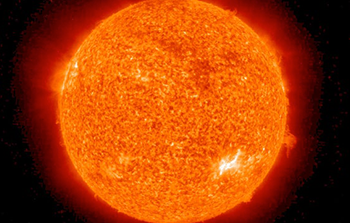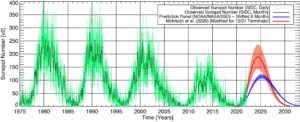
April 5, 2022
New research [1] predicts that the new solar cycle (SC25) is going to be stronger than initially expected. It is now believed solar cycle (SC25) will be at similar intensity as SC23 which brought us the famous Halloween Storm of October 2003 which caused widespread blackouts in Sweden [2] and significant damage to transformers in the local power grid and other middle latitude regions [3].
This new forecast is somewhat controversial as it deviates significantly from the forecast of the Solar Cycle 25 Prediction Panel (SC25PP) that SC25 will be mild (akin to SC24) [4].
McIntosh, Chapman and others (2020) [1] published a paper and explained how the duration and timing of the transition between the old and new solar cycle — the “terminator” — could be used to predict the amplitude of the new solar cycle.
This relationship was established by analysing 270 years of solar cycle data, mostly contained in sunspot number observations. By using fairly standard signal processing techniques — Hilbert transforms — they found that there is a linear relationship between the duration between terminator events and the intensity of the solar activity cycle.
The magnetic structures that define the helio-magnetic field differ slightly for every cycle and a certain amount of locally imbalanced magnetic field at any one time is needed to form an active area. In other words, the structures in the solar magnetic field react with each other and, McIntosh, et al. postulates, that longer overlap periods between structures mean they more effectively cancel each other resulting in a weaker cycle. The opposite also holds: shorter termination periods result in a more intense cycle.
A recent re-analysis of their work (see [5] and tweets by the author [6]), utilising this method and recent sunspot observations of transition between SC24 and 25, predicts that the peak of SC25 will have sunspot number (SSN) of about 230. This is significantly higher than the 130 SSN predicted by SC25PP.
The difference is significant — we are now looking at a strong cycle, compared to the very moderate predictions. We can see this in action in the graph below that shows the comparison between the old and new predictions. The Macintosh, et al. model is in agreement with current sunspot numbers, while the milder prediction underestimates the current levels.
The take-home message for SANSA is three-fold:
- Historical data sets are valuable and continue to enable us to make new discoveries.
- By striving for a complete understanding of our physical world we can make significant advances in practical matters like solar cycle prediction.
- Space weather and the upstream physical phenomena are dynamic and ever-changing. In order to do long term risk mitigation and planning, we have to be nimble enough to react to changes in the understanding of the upstream physics.

References:
[1] McIntosh, S.W., Chapman, S., Leamon, R.J. et al. Overlapping Magnetic Activity Cycles and the Sunspot Number: Forecasting Sunspot Cycle 25 Amplitude. Sol Phys 295, 163 (2020). https://doi.org/10.1007/s11207-020-01723-y
[2] Lundstedt, H. (2006). The sun, space weather and GIC effects in Sweden. Advances in Space Research, 37(6), 1182–1191. https://doi.org/10.1016/j.asr.2005.10.023
[3] Gaunt, C. T. (2014). Reducing uncertainty – responses for electricity utilities to severe solar storms. Journal of Space Weather and Space Climate, 4, A01. https://doi.org/10.1051/swsc/2013058
[4] https://www.weather.gov/news/190504-sun-activity-in-solar-cycle
[5] https://spaceweather.com/archive.php?view=1&day=01&month=03&year=2022
[6] https://twitter.com/swmcintosh/status/1482139426075693059


